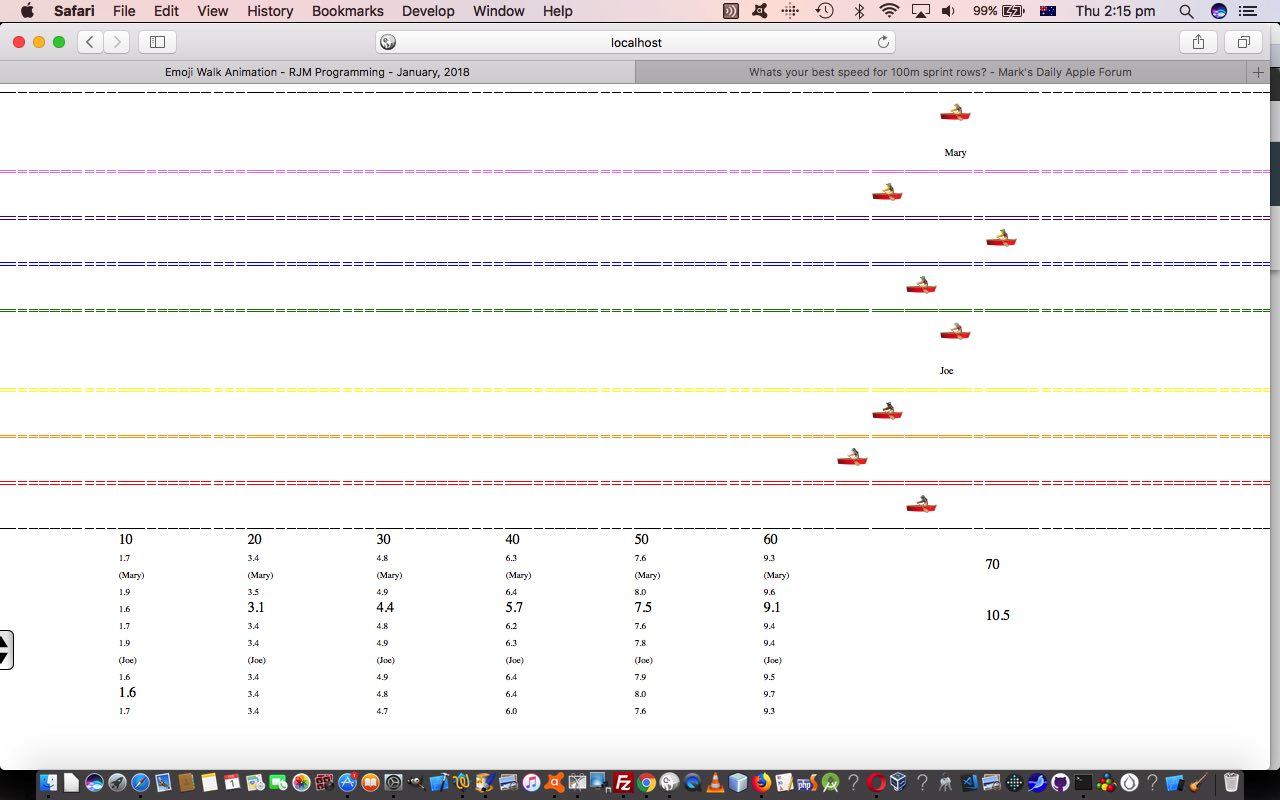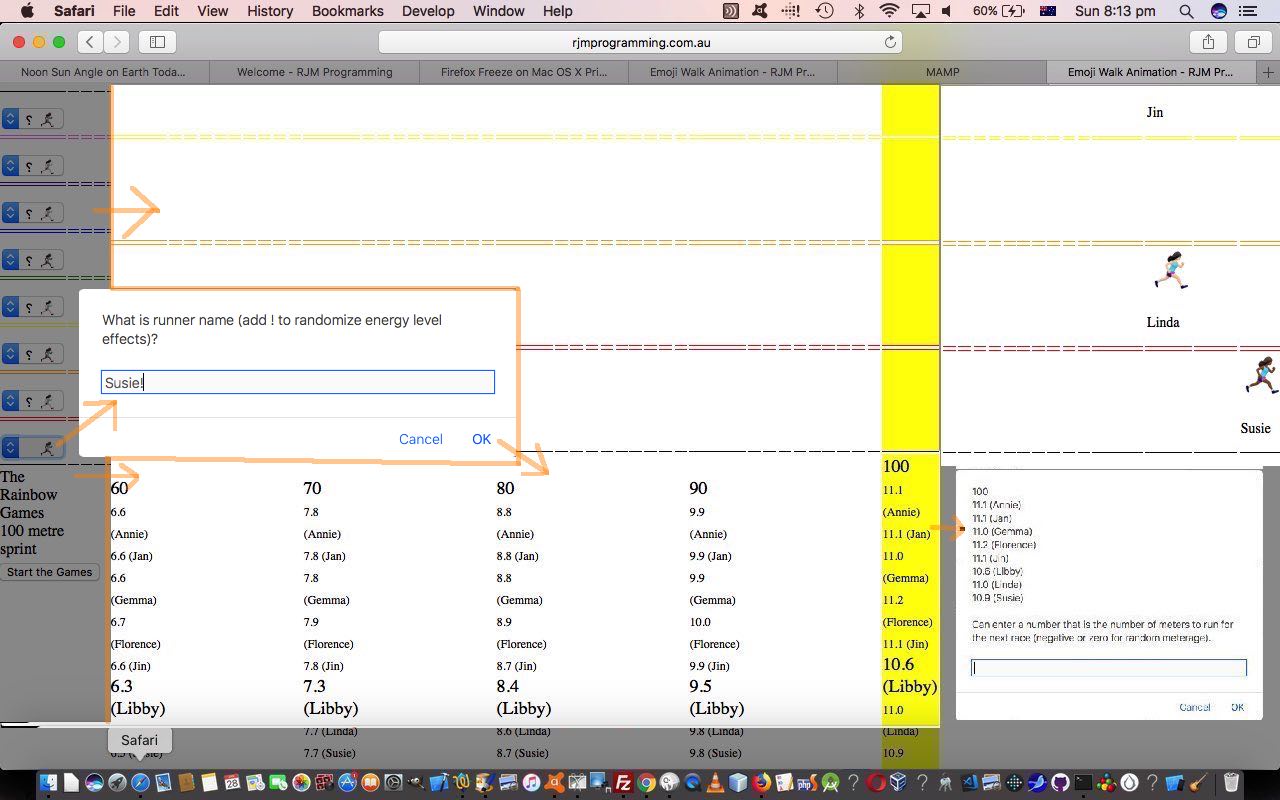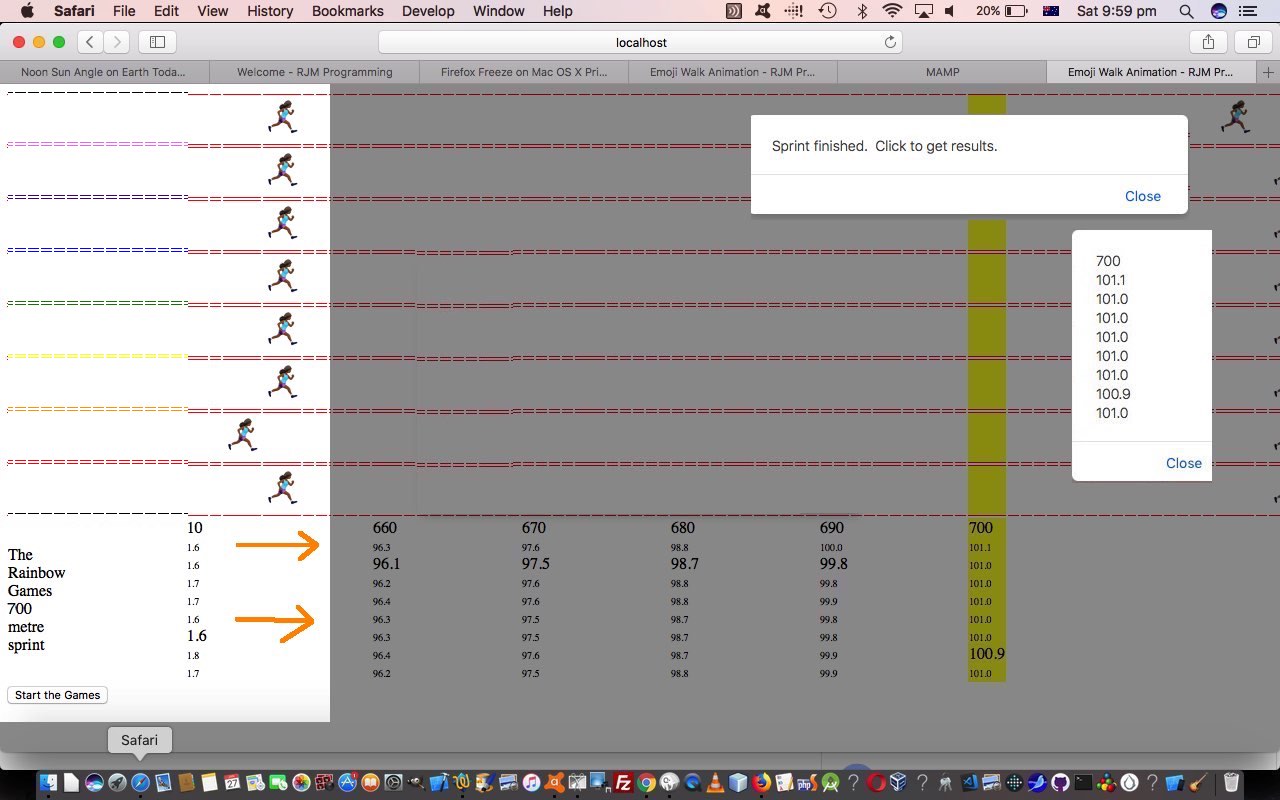What would help genericize the recent Rainbow Games Double Transformation Tutorial “Rainbow Games” web application? How about introducing another sport?
Again, in honour of “onions of the 4th dimension” approaches, we mainly, turn to the power of Javascript’s eval methodology to achieve this abstracted feeling to our web application. Today, with this, we go two thirds of the way along the “Mathematical Induction” approach …
- prove for the first case
- prove for the second case
- prove for the nth case
How does this use of Javascript eval manifest itself in this way?
- there are two arrays that work with the “content” of our “Rainbow Games” sport(s) (well, at least, the first “sprint running” sport) called emoticons[] and choices[]
- wherever we find references in the code to either of these two arrays we start to involve the global variable verbsuffix …
var verb='Sprint';
var verbs=['Sprint','Row'];
var anotherverb='run';
var verbsuffix='';
… in altered ways like …
function plus(ih,ihep) {
var outihep=ihep;
if (eval("emoticons" + verbsuffix + "[" + ih + "]").indexOf('<p>') != -1) {
outihep += ' (' + eval("emoticons" + verbsuffix + "[" + ih + "]").split('<p>')[1].split('<')[0] + ')';
}
return outihep;
}
… in that abstracted way … noting that sometimes you don’t need the “eval()” encasings … - and so, working through the code this way it just falls to the coder to define new members for all the arrays for all the new sports (ours is “rowing” today), some of those new arrays (like for rowing are emoticonsrowing[] and choicesrowing[]) to involve …
- looking up emoji definitions from …
… not forgetting to …
- make sure the event logics work for multiple sport scenarios … but mostly they do by sticking to the principles above … especially for the …
- new HTML select (dropdown) element allows the user to pick a sport
Remaining a work in progress, you can try out our live run link that has underlying HTML and Javascript and CSS emoji_walk_animation.htm, and which changed in this way regarding today’s genericization work. We hope it gives you food for thought.
Previous relevant Rainbow Games Double Transformation Tutorial is shown below.
We were on the “road to personalization” for the web application game we started with yesterday’s Rainbow Games Primer Tutorial when “an old chestnut” came up again. It’s happened before, the desire to “double transform” in CSS came about from our emoji …
| 🏃🏾♀️ |
… table cell mirroring styling as per …
<style>
* { overflow-x: visible; }
select { font-size: 36px; }
td.runner { width: 50px; word-wrap: break-word; font-size: 36px;
transform: scale(-1, 1); -o-transform: scale(-1, 1); -moz-transform: scale(-1, 1); -ms-transform: scale(-1, 1); -webkit-transform: scale(-1, 1);
} //
| 🏃🏾♀️ |
tr { max-height: 40px; }
</style>
… necessary to make our running emojis run from left to right (that, alas, also transformed any accompanying …
| 🏃🏾♀️
Florence |
… name), was added to in this double transformational clause to prove what this wonderful web page advice had to say. In other words, a “double transform” CSS styling scenario like the one below …
<style>
* { overflow-x: visible; }
select { font-size: 36px; }
td.runner { width: 50px; word-wrap: break-word; font-size: 36px;
transform: scale(-1, 1); -o-transform: scale(-1, 1); -moz-transform: scale(-1, 1); -ms-transform: scale(-1, 1); -webkit-transform: scale(-1, 1);
}
tr { max-height: 40px; }
p {
display: block;
font-size: 12px;
-webkit-transform: matrix(-1, 0, 0, 1, 0, 0);
-moz-transform: matrix(-1, 0, 0, 1, 0, 0);
-o-transform: matrix(-1, 0, 0, 1, 0, 0);
transform: matrix(-1, 0, 0, 1, 0, 0);
} //
| 🏃🏾♀️
Florence |
</style>
… works as a “double transform” to first …
- mirror (image) flip the table cell (td) emoji data … but us appending some “Runner Name” textual data underneath also, annoyingly, got flipped until …
- within that (same) table cell (td) element and after the emoji data we append an HTML p(aragraph) element to both …
- introduce a new HTML element type into the (CSS styling) mix … and to …
- introduce a new CSS transformation type, the matrix … perhaps either or both new parts to the problem critical to its success when, believe me, lots of other approaches don’t work
… to personalize the “runners” and “users”, optionally, “into the game”, by allowing the “user” to name their “runners” and allow for a “runner energy” setting be a bit randomized, to add for some other interest “variety” to the game’s workings. So, still a work in progress that you can try out at our live run link that has underlying HTML and Javascript and CSS emoji_walk_animation.html, and which changed in this way regarding today’s work.
Previous relevant Rainbow Games Primer Tutorial is shown below.
It’s been a while since we’ve written any conventional HTML and Javascript and CSS game. Today’s game uses the “emoticon” section of the Emoji character set, defaulting so far, to the “running woman” emoji featuring in Compound Emoji WordPress Usage Tutorial.
It’s the early days of our “Rainbow Games” web application, and we’re starting with the animation featuring horizontal hashtag navigation techniques for a running race start to our game. Where it finishes? Hard to say! Today, we’ve looked at “splits” and a finish line.
You can try out our burgeoning live run game concept link that has underlying HTML and Javascript and CSS emoji_walk_animation.html.
If this was interesting you may be interested in this too.
If this was interesting you may be interested in this too.
If this was interesting you may be interested in this too.





